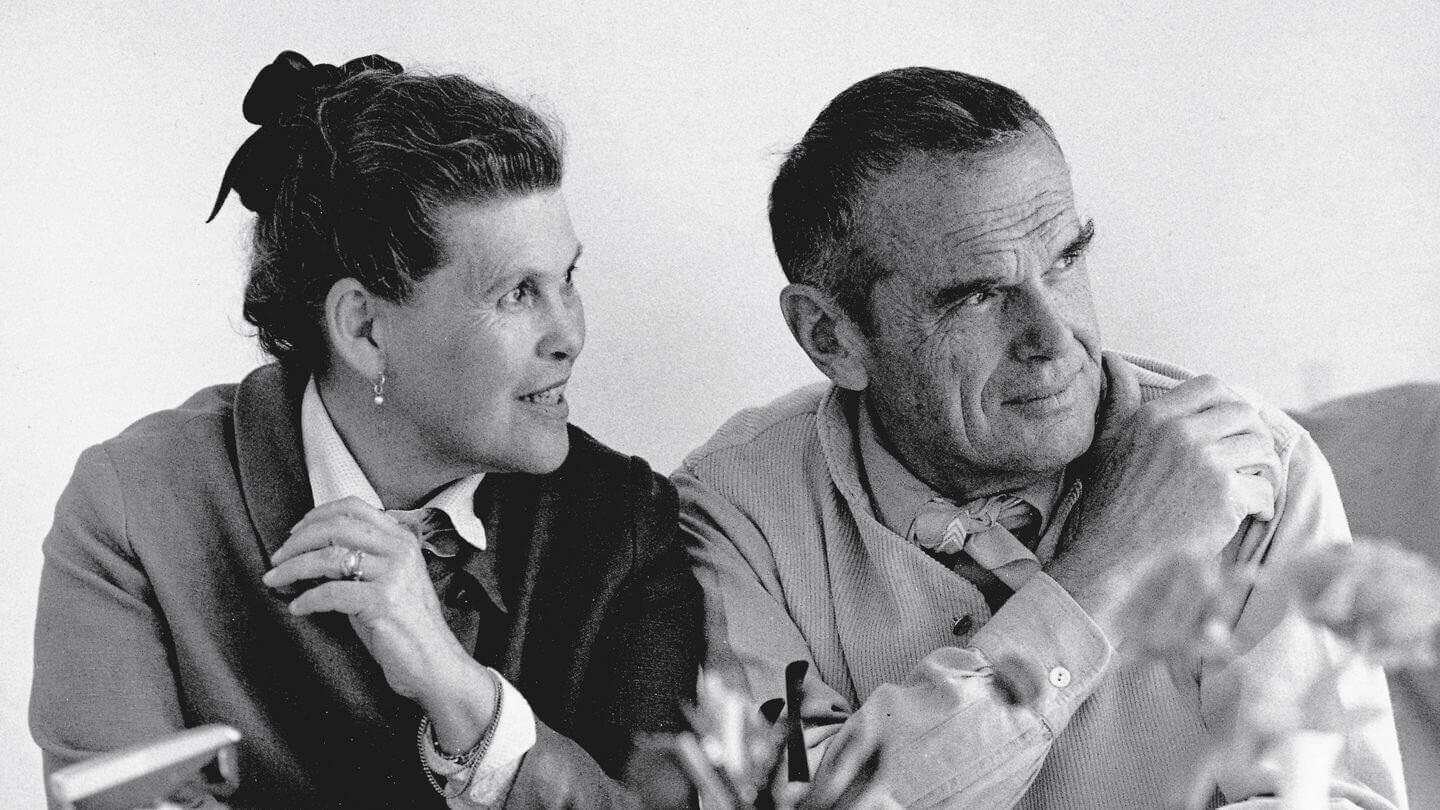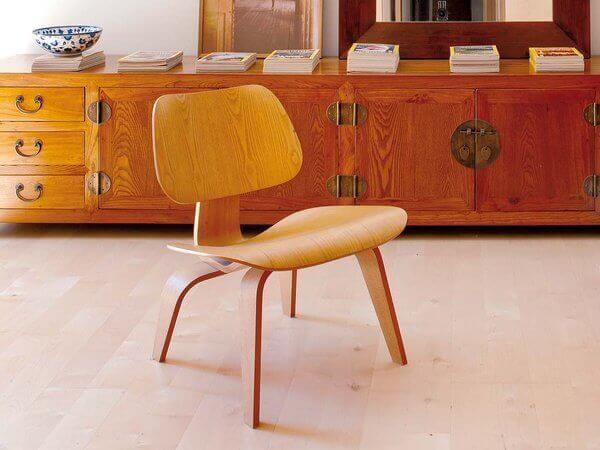Design Duo Charles and Ray Eames

Charles and Ray Eames were a dynamic duo that created many iconic furniture pieces and product designs in the 20th century. The US pair boasted an enormous creative capacity and made important contributions in modern design and architecture. Aside from architecture, the pair also worked in furniture design, contraptions and film as well.
Charles Eames

Charles Ormod Eames was born in 1907. When he grew up, he studied Architecture for a short time at Washington University in St. Louis from 1925 to 1928 before he was expelled. Many sources claim that his expulsion was a result of his fierce defense of Modern Architecture and Frank Lloyd Wright.
After his time at Washington University, he traveled to Europe in 1929 and there, connected with the biggest minds of the modern architectural movement. Among them, Le Corbusier, Mies van der Rohe, and Walter Gropius.
After returning from Europe, Eames opened an architectural studio in St. Louis in 1930 alongside Charles Gray and Walter Pauley. Unfortunately, the group closed their studio in 1934 due to a lack of commissions.
But Eames opened another architectural studio in 1935 with Robert Walsh and presented the Meyer House in Huntleigh Village to announce their partnership. Eames found a great deal of inspiration from the Finnish architect Eliel Saarinen, and his son, Eero and completed joint projects with them.
Together with Eero Saarinen, Charles submitted their furniture to MoMA’s Organic Design in Home Furnishings exposition panel and won prizes for their designs.
They used and improved Alvar Aalto’s wood bending technique. Later, Eliel Saarinen would grant Charles a scholarship to study design at the Cranbrook Academy of Art, where he would later be a professor in 1939.
A year later, in 1940, he ascended to be the head of the Department of Industrial Design. 1940 continued to be an important year for Charles and Modern Design as he would later meet new Cranbrook student Ray Kaiser, his future wife.
Ray Eames

Ray-Bernice Alexandra Kaiser Eames was born in 1912 in Sacramento, California. After moving around several cities during her youth, she went on to study at Bennett College and graduated in 1933.
After graduating she continued to study painting in New York with Hans Hofmann. Later, she founded the American Artist Group in 1936 and a year later, opened her first exposition in the Riverside Museum in Manhattan.
She would eventually follow her path to Cranbrook. At Cranbrook, she met and worked alongside Charles Eames and Eero Saarinen, preparing designs for the MoMA’s Organic Furniture competition.
What works good is better than what looks good because what works good lasts.
-Ray Eames-
Design duo, the Eames

Charles Eames and Ray Kaiser married in Chicago in 1941. After, they moved to Los Angeles to start a design journey together; it was the beginning of a successful career. Later, towards the end of the ’40s, the pair designed and constructed the Eames House, also known as the Case Study House #8, for the Art & Architecture magazine’s program Case Study. It would later become their actual home.
In Los Angeles, Charles worked as a set designer for MGM media company. As he worked there, the pair continued designing and created the Kazam! machine, which was a wooden press that was bent into complex curves through two geometric planes. Later in 1942, they founded the Plyformed Wood Company, which produces five-thousand wooden boards a day for the United States Army.
But the couple would later sell the company in light of economic problems. Though the company was no longer their own, Charles continued as the Research and Development Director for several years.
Furniture pieces that won prizes

In 1946, MoMA organized an exposition called “New Furniture by Charles Eames.” The exposition introduced the famous Plywood chairs, which were designed by the couple in 1945-1946.
The chairs aimed to provide a high-quality design at an economical price. Shortly after, the Evans company picked up the design and started to produce the chairs. Herman Miller continued the process, distributing and commercializing them in 1949.
A year earlier in 1948, the Eames couple won the second prize for MoMA’s International Competition for Low-Cost Furniture Design with an innovative entry. They submitted a set of fiberglass chairs. The submission was a first of its kind: plastic chairs with no kind of lining.
The chairs stemmed from a simple yet innovative concept. Their structure was also simple and featured various variations. The design converted it into a universal piece of furniture that would greatly impact 20th-century design and architecture.
Charles and Ray Eames were a dynamic duo that created many iconic furniture pieces and product designs in the 20th century. The US pair boasted an enormous creative capacity and made important contributions in modern design and architecture. Aside from architecture, the pair also worked in furniture design, contraptions and film as well.
Charles Eames

Charles Ormod Eames was born in 1907. When he grew up, he studied Architecture for a short time at Washington University in St. Louis from 1925 to 1928 before he was expelled. Many sources claim that his expulsion was a result of his fierce defense of Modern Architecture and Frank Lloyd Wright.
After his time at Washington University, he traveled to Europe in 1929 and there, connected with the biggest minds of the modern architectural movement. Among them, Le Corbusier, Mies van der Rohe, and Walter Gropius.
After returning from Europe, Eames opened an architectural studio in St. Louis in 1930 alongside Charles Gray and Walter Pauley. Unfortunately, the group closed their studio in 1934 due to a lack of commissions.
But Eames opened another architectural studio in 1935 with Robert Walsh and presented the Meyer House in Huntleigh Village to announce their partnership. Eames found a great deal of inspiration from the Finnish architect Eliel Saarinen, and his son, Eero and completed joint projects with them.
Together with Eero Saarinen, Charles submitted their furniture to MoMA’s Organic Design in Home Furnishings exposition panel and won prizes for their designs.
They used and improved Alvar Aalto’s wood bending technique. Later, Eliel Saarinen would grant Charles a scholarship to study design at the Cranbrook Academy of Art, where he would later be a professor in 1939.
A year later, in 1940, he ascended to be the head of the Department of Industrial Design. 1940 continued to be an important year for Charles and Modern Design as he would later meet new Cranbrook student Ray Kaiser, his future wife.
Ray Eames

Ray-Bernice Alexandra Kaiser Eames was born in 1912 in Sacramento, California. After moving around several cities during her youth, she went on to study at Bennett College and graduated in 1933.
After graduating she continued to study painting in New York with Hans Hofmann. Later, she founded the American Artist Group in 1936 and a year later, opened her first exposition in the Riverside Museum in Manhattan.
She would eventually follow her path to Cranbrook. At Cranbrook, she met and worked alongside Charles Eames and Eero Saarinen, preparing designs for the MoMA’s Organic Furniture competition.
What works good is better than what looks good because what works good lasts.
-Ray Eames-
Design duo, the Eames

Charles Eames and Ray Kaiser married in Chicago in 1941. After, they moved to Los Angeles to start a design journey together; it was the beginning of a successful career. Later, towards the end of the ’40s, the pair designed and constructed the Eames House, also known as the Case Study House #8, for the Art & Architecture magazine’s program Case Study. It would later become their actual home.
In Los Angeles, Charles worked as a set designer for MGM media company. As he worked there, the pair continued designing and created the Kazam! machine, which was a wooden press that was bent into complex curves through two geometric planes. Later in 1942, they founded the Plyformed Wood Company, which produces five-thousand wooden boards a day for the United States Army.
But the couple would later sell the company in light of economic problems. Though the company was no longer their own, Charles continued as the Research and Development Director for several years.
Furniture pieces that won prizes

In 1946, MoMA organized an exposition called “New Furniture by Charles Eames.” The exposition introduced the famous Plywood chairs, which were designed by the couple in 1945-1946.
The chairs aimed to provide a high-quality design at an economical price. Shortly after, the Evans company picked up the design and started to produce the chairs. Herman Miller continued the process, distributing and commercializing them in 1949.
A year earlier in 1948, the Eames couple won the second prize for MoMA’s International Competition for Low-Cost Furniture Design with an innovative entry. They submitted a set of fiberglass chairs. The submission was a first of its kind: plastic chairs with no kind of lining.
The chairs stemmed from a simple yet innovative concept. Their structure was also simple and featured various variations. The design converted it into a universal piece of furniture that would greatly impact 20th-century design and architecture.







